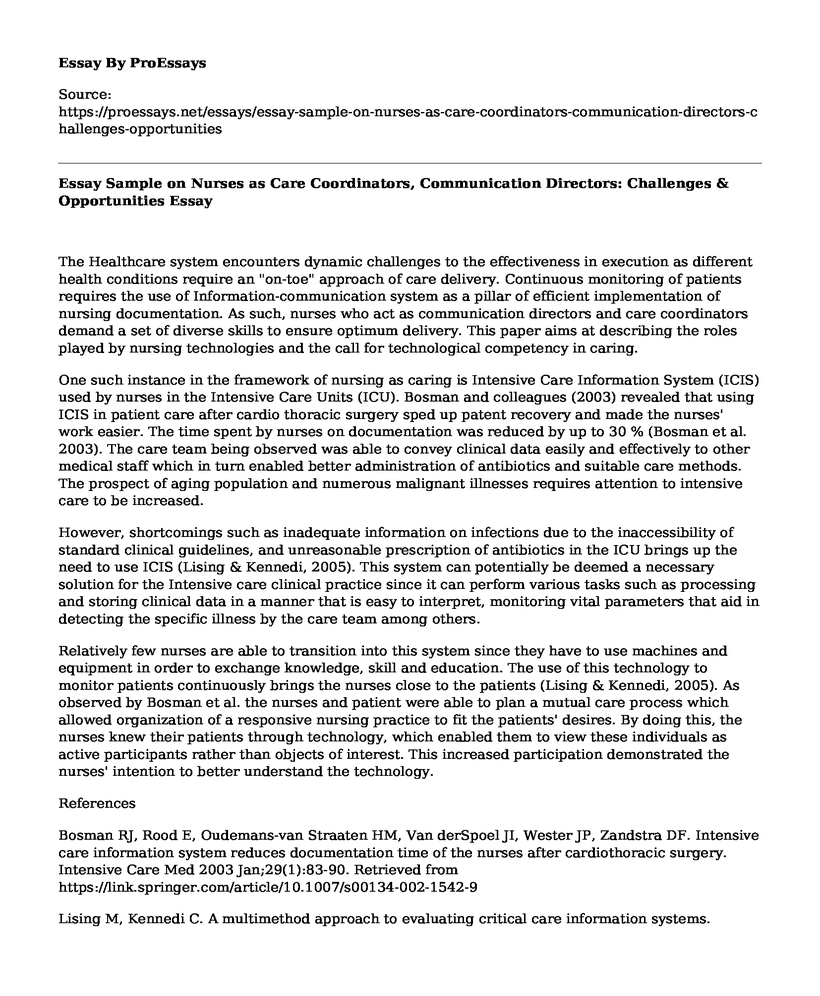The Healthcare system encounters dynamic challenges to the effectiveness in execution as different health conditions require an "on-toe" approach of care delivery. Continuous monitoring of patients requires the use of Information-communication system as a pillar of efficient implementation of nursing documentation. As such, nurses who act as communication directors and care coordinators demand a set of diverse skills to ensure optimum delivery. This paper aims at describing the roles played by nursing technologies and the call for technological competency in caring.
One such instance in the framework of nursing as caring is Intensive Care Information System (ICIS) used by nurses in the Intensive Care Units (ICU). Bosman and colleagues (2003) revealed that using ICIS in patient care after cardio thoracic surgery sped up patent recovery and made the nurses' work easier. The time spent by nurses on documentation was reduced by up to 30 % (Bosman et al. 2003). The care team being observed was able to convey clinical data easily and effectively to other medical staff which in turn enabled better administration of antibiotics and suitable care methods. The prospect of aging population and numerous malignant illnesses requires attention to intensive care to be increased.
However, shortcomings such as inadequate information on infections due to the inaccessibility of standard clinical guidelines, and unreasonable prescription of antibiotics in the ICU brings up the need to use ICIS (Lising & Kennedi, 2005). This system can potentially be deemed a necessary solution for the Intensive care clinical practice since it can perform various tasks such as processing and storing clinical data in a manner that is easy to interpret, monitoring vital parameters that aid in detecting the specific illness by the care team among others.
Relatively few nurses are able to transition into this system since they have to use machines and equipment in order to exchange knowledge, skill and education. The use of this technology to monitor patients continuously brings the nurses close to the patients (Lising & Kennedi, 2005). As observed by Bosman et al. the nurses and patient were able to plan a mutual care process which allowed organization of a responsive nursing practice to fit the patients' desires. By doing this, the nurses knew their patients through technology, which enabled them to view these individuals as active participants rather than objects of interest. This increased participation demonstrated the nurses' intention to better understand the technology.
References
Bosman RJ, Rood E, Oudemans-van Straaten HM, Van derSpoel JI, Wester JP, Zandstra DF. Intensive care information system reduces documentation time of the nurses after cardiothoracic surgery. Intensive Care Med 2003 Jan;29(1):83-90. Retrieved from https://link.springer.com/article/10.1007/s00134-002-1542-9
Lising M, Kennedi C. A multimethod approach to evaluating critical care information systems. Computers Informatics Nursing. 2005;23(1):27-37. Retrieved from https://journals.lww.com/cinjournal/Fulltext/2005/01000/A_Multimethod_Approach_to_Evaluating_Critical_Care.7.asp
Cite this page
Essay Sample on Nurses as Care Coordinators, Communication Directors: Challenges & Opportunities. (2023, Apr 04). Retrieved from https://proessays.net/essays/essay-sample-on-nurses-as-care-coordinators-communication-directors-challenges-opportunities
If you are the original author of this essay and no longer wish to have it published on the ProEssays website, please click below to request its removal:
- Paper Example on Communication Skills and Conflict Resolution in Nursing
- Essay Sample on Blue Cross Blue Shield of Massachusetts
- Epiville Control Case Study
- Alzheimer Disease and the Problem Encountered by the Families of Patients Paper Example
- Essay Sample on Phagocytic Disorders & Vascular Diseases: A Cardiovascular Pathophysiologic Process
- Essay Example on COVID-19: The Impact of Remote Working on Jobs and Businesses
- Assessing Nutritional Status: A Major Issue - Essay Sample







